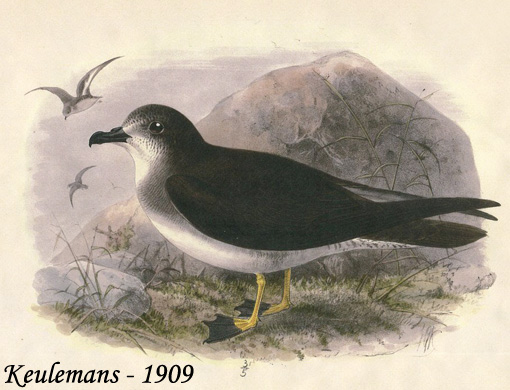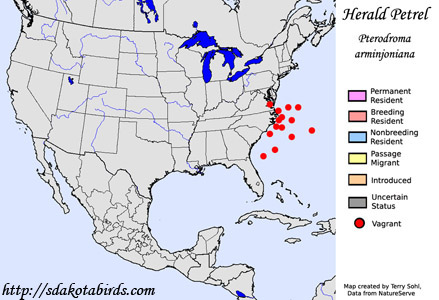Trindade Petrel
Pterodroma arminjoniana
| Length: 15 inches | Wingspan: 35 inches | Seasonality: Non-resident in South Dakota |
| ID Keys: Short stubby bill. Two color morphs, dark is all dak, light is dark above, lighter below. | ||
 The
Herald Petrel has a confusing taxonomy, with different sources offering
different opinions on status as a species. The Pterodroma
arminjoniana described here is restricted to a few breeding islands in
the South Atlantic, but has been a rare but relatively regular vagrant to
the north Atlantic off the coast of the Carolinas. This population is
also known as the Herald Petrel, but the Trindade Petrel is named for an island group where it
breeds. What some consider the true "Herald Petrel" is Peterodroma
heraldica, a bird of the Pacific Ocean. A darker-looking version of the
Pacific "Herald Petrel" is Peterodroma atrata. The three
individual populations have all carried the moniker "Herald Petrel", and
taxonomy is still in dispute. The Herald Petrel was originally named
by the naturalist who first identified it, who named it after the HMS
Herald, the ship he was traveling on at the time.
The
Herald Petrel has a confusing taxonomy, with different sources offering
different opinions on status as a species. The Pterodroma
arminjoniana described here is restricted to a few breeding islands in
the South Atlantic, but has been a rare but relatively regular vagrant to
the north Atlantic off the coast of the Carolinas. This population is
also known as the Herald Petrel, but the Trindade Petrel is named for an island group where it
breeds. What some consider the true "Herald Petrel" is Peterodroma
heraldica, a bird of the Pacific Ocean. A darker-looking version of the
Pacific "Herald Petrel" is Peterodroma atrata. The three
individual populations have all carried the moniker "Herald Petrel", and
taxonomy is still in dispute. The Herald Petrel was originally named
by the naturalist who first identified it, who named it after the HMS
Herald, the ship he was traveling on at the time.
Habitat: Breeds on the Trindade and Martin Vaz islands off the coast of Brazil. Pelagic outside of breeding, often found far out to sea, but also sometimes found relatively near coastlines.
Diet: Feeds on squid, crustaceans, and small fish.
Behavior: Forages by flying over the water's surface, dropping down to skim prey items from the surface or just below the surface, then resuming flight and consuming the prey while flying.
Nesting: The Trindade Petrel doesn't build a nest, but lays a single egg in a rock crevice or cavity. Both parents help to incubate the eggs, and both tend to the young and feed it upon hatching.
Song: Generally silent while away from breeding colonies. Makes whinnying sounds on the breeding grounds.
Migration: Breed on a handful of islands in the south Atlantic ocean, off the coast of South America. After breeding, wanders widely across the Atlantic, with evidence that they may regularly wander to some parts of the North Atlantic.
Interactive eBird Map: Click here to access an interactive eBird map of Trindade Petrel sightings
Similar Species: Very similar to Murphy's Petrel, but that species is found in the Pacific basin. Also possibly confused with the Black-capped Petrel, or Fea's Petrel.
Conservation Status: The nesting range of the Trindade Petrel is very small, and introduced predators have negatively impacted breeding populations. The global population is low, with a total population likelyi below 20,000. The IUCN lists the Trindade Petrel as a "Vulnerable" species.
Further Information: 1) Birds.com - Herald Petrel
2) BirdLife International - Trinidade Petrel
3) PlanetBirds - Trinidade Petrel
Image Information: Image from Godman's 'Monograph of the Petrels', 1909. Plate by artist John Gerrard Keulemans, 1842--1912. Copyright expired in the U.S., public domain image.
| Click below for a higher-resolution map |
 |
| South Dakota Status: Non-resident in South Dakota. |
Additional Herald Petrel Photos (coming soon!!)
